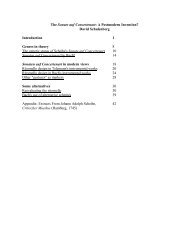SEVEN PAPERS ON EXISTENTIAL ANALYSIS ... - Wagner College
SEVEN PAPERS ON EXISTENTIAL ANALYSIS ... - Wagner College
SEVEN PAPERS ON EXISTENTIAL ANALYSIS ... - Wagner College
You also want an ePaper? Increase the reach of your titles
YUMPU automatically turns print PDFs into web optimized ePapers that Google loves.
a role to play (“B”) while she looked for “better parts” in the “real world” of a television<br />
series or a film.<br />
B is well-informed about psychoanalytic determinism and looks for “reasons” for<br />
her attitudes and motivations in early childhood experiences. She has little confidence in<br />
the example set for her by her parents, who were separated for 18 years but did not<br />
divorce, and recently have been living together again.<br />
She reports that her teachers at university disappointed her, although given her<br />
excellent verbal skills, she says she was able to “fool” them into believing she was<br />
interested in what they wanted her to “have”: a degree, a teaching position, a career in<br />
academe, and tenure at an “important” college or university.<br />
She does not feel close to anyone, is critical of her appearance, and resentful of<br />
how others dictate how she should look, even while pursuing a “career” that is based on<br />
the creation of personae. Men have also disappointed her by what B perceives as their<br />
being either stupid and weak or exploitative and dangerous, with nothing in between. A<br />
woman had been interested in her sexually, but she could not respond. On the whole,<br />
she does not like the company of women. The advantages afforded B by scholarships,<br />
grants for study, and the privileges of an upper middle-class family income have all<br />
disappointed her, as have Los Angeles and New York, both of which she sees as merely<br />
offering her distraction and entertainment, a “set” or stage on which to enact her life as<br />
“B”.<br />
The existential gap between B and “B” was a measure of the distance of this<br />
young woman’s experience from her existential authenticity. Since the gap is inevitable,<br />
my stance as an existential analyst was fundamentally one of “no blame.” Given B’s<br />
recognition of the gap, a therapeutic partnership was both possible and desirable. To<br />
put it somewhat schematically and artificially: the partnership did not aim at intervening<br />
in “B”’s existence on behalf of B, but rather in allowing B’s self-realization to play itself out.<br />
There was no lost version of B to be found, restored and reinstated, and no incomplete<br />
version of B to be “finished” (as the psychoanalytic view might propose).<br />
“B” was not an improperly constructed or deformed version of B in need of being<br />
refashioned or “straightened out” (as a behaviorist might see her), nor was it merely a<br />
matter of B’s thinking about herself differently that would allow “B” and B to coincide. B<br />
was unacknowledged possibility.<br />
In existential analysis, the most a therapeutic partnership can provide is recognition of<br />
possibilities that have heretofore been seen as problems. It is not a matter of re-cognition, but of<br />
seeing afresh. I saw B’s so-called “disturbances” not as perturbations of some imagined<br />
“normal” state, but rather unformulated questions about how she can be, which means<br />
precisely how she already is (as B) if only she were free to be in that way and not have to create<br />
the role “B”.<br />
A therapeutic partnership in existential analysis does not have an outcome, whether it be<br />
set in terms of the short run (as adjustment) or envisioned as the culmination of a long voyage of<br />
self-rediscovery leading to insight (as in psychoanalysis). Authenticity, then, may be best<br />
understood as a new beginning in the fullness of inauthentic existence (in this case “B”).<br />
Authenticity is an option for someone only because she has embraced her inauthenticity. The<br />
story of B illustrates this especially well. The freedom that is engaged or “put in gear” is not an<br />
escape from inauthenticity but rather the reappearance of a capacity for self-authorship in the<br />
unavoidable context of inauthenticity. “B” continued to play her role, but B was granted<br />
disclosure as the underlying possibility that made had permitted “B” to be created and invested<br />
with social salience.<br />
The therapeutic partnership affords someone the experience of this paradox of<br />
existence. The pleasure of work as an existential analyst is witnessing the unexpected<br />
emergence of human freedom.















